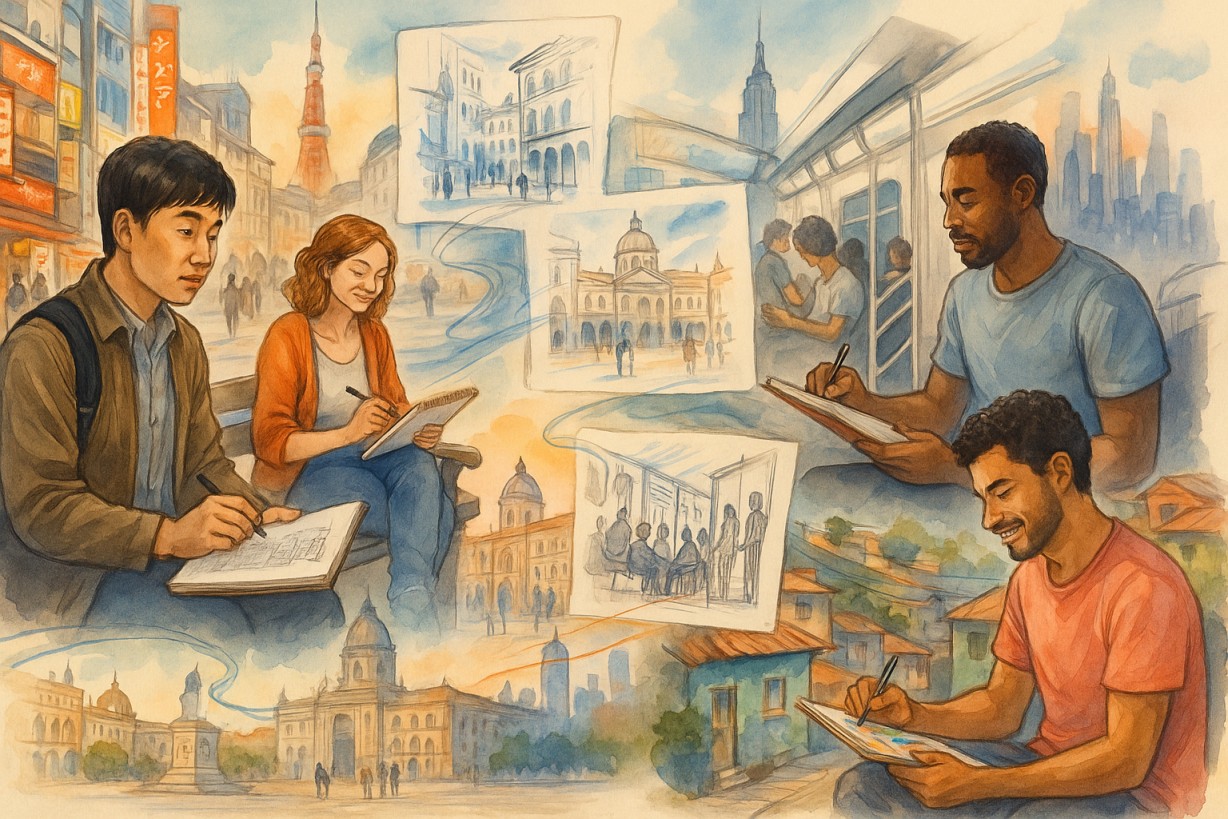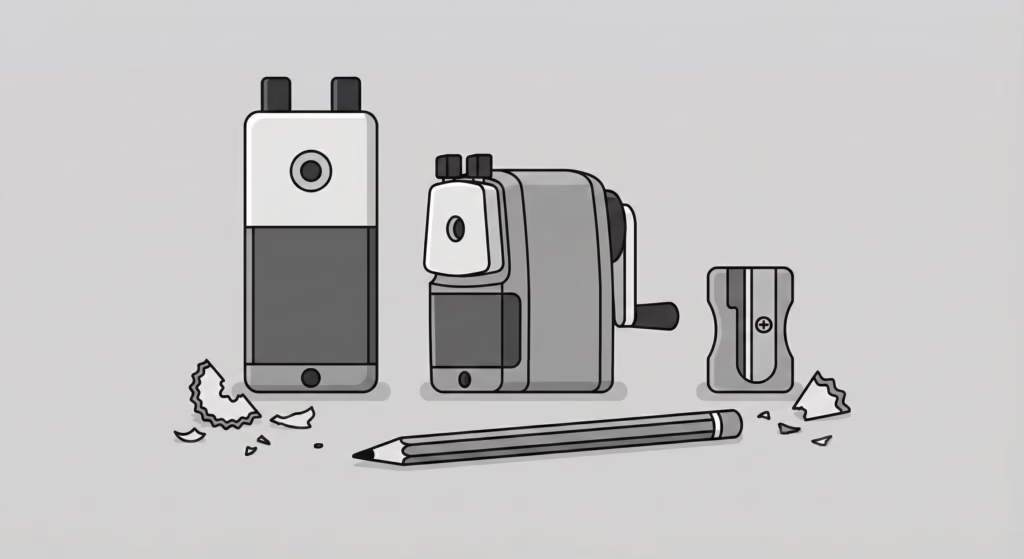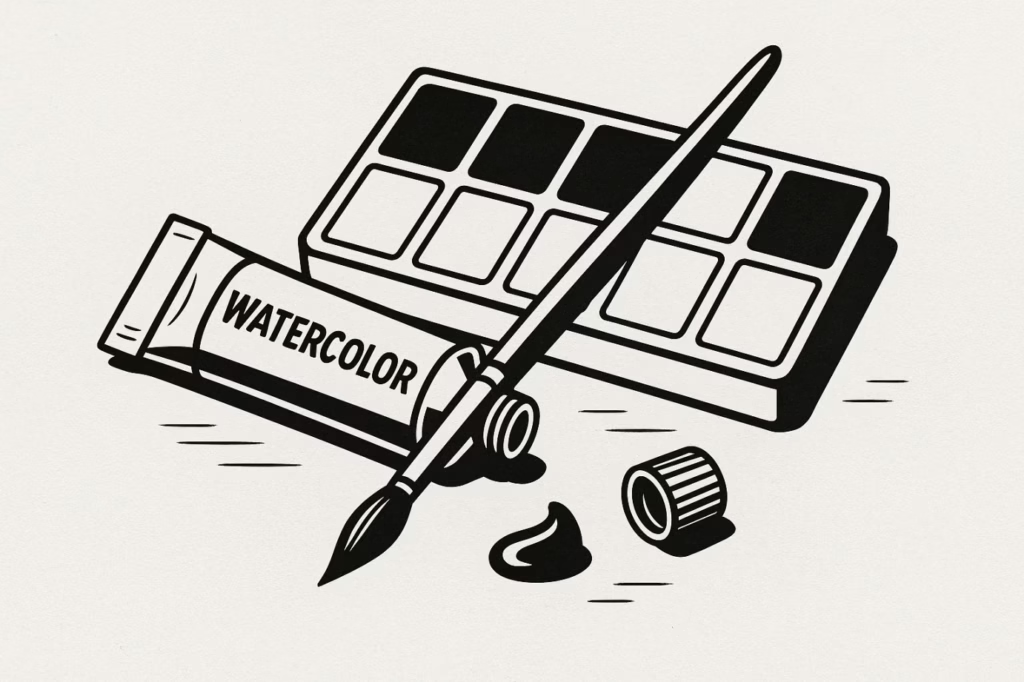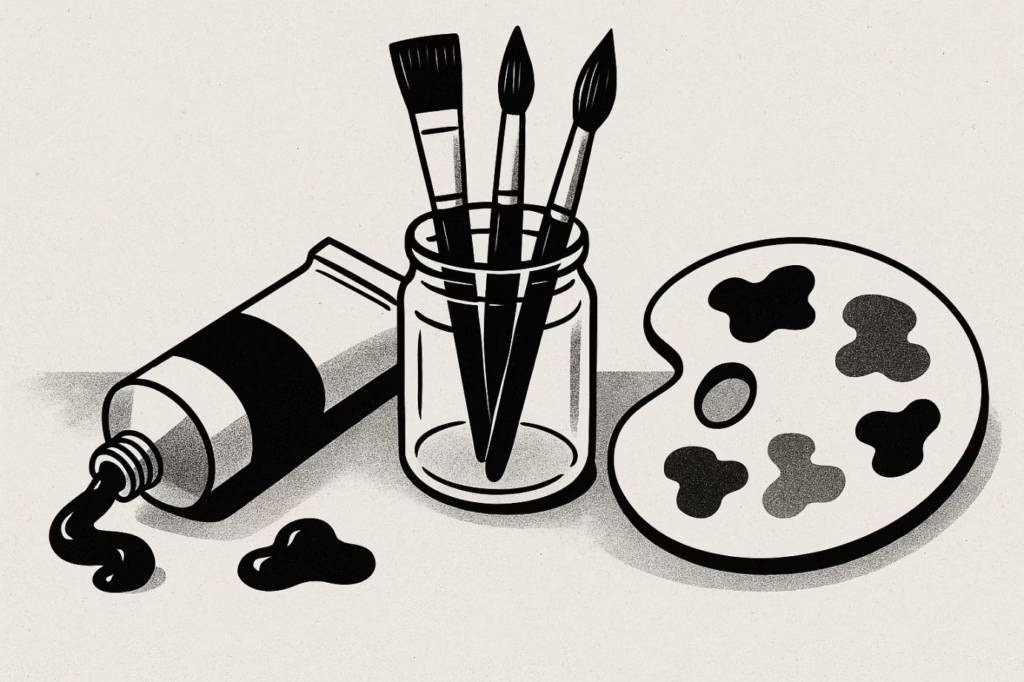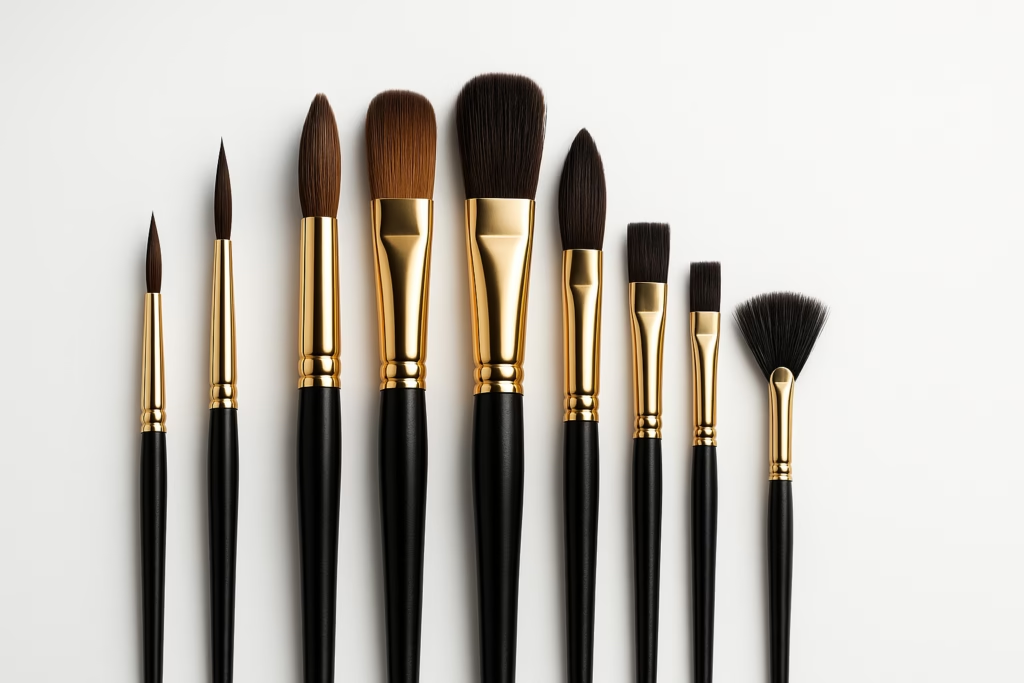At exactly 3:47 PM on a Tuesday, Yuki carefully positions her watercolor set on a Tokyo park bench, sketching the bustling Shibuya crossing. Half a world away, at the same moment, Carlos sits in São Paulo’s Vila Madalena, capturing the vibrant street murals in his moleskine. They’ve never met, yet they’re part of something extraordinary—a global movement that’s quietly revolutionizing how millions of people connect with their cities and each other.
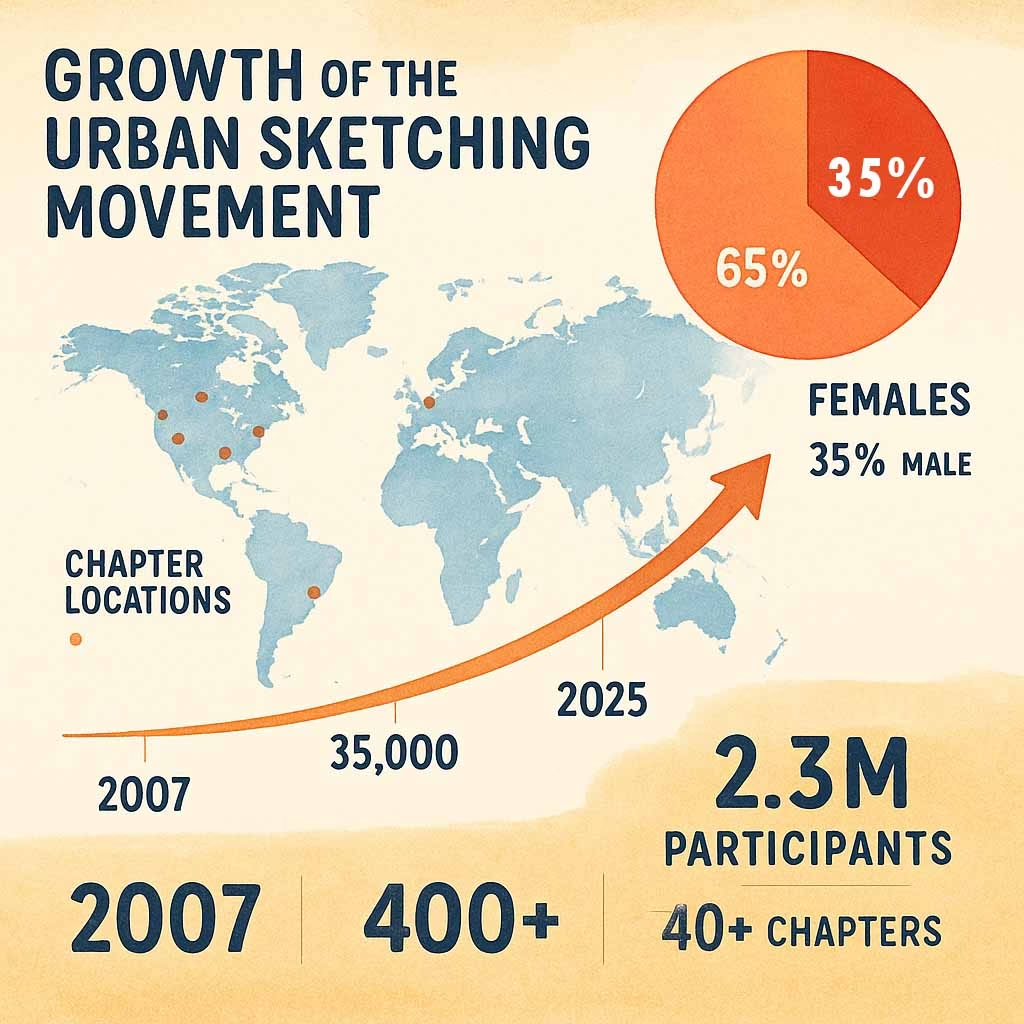
Welcome to the world of urban sketching communities, where strangers become friends over shared pencil shavings and where documenting everyday urban life has evolved into the most inclusive art movement of the 21st century.
What started as one journalist’s simple idea in a Seattle coffee shop has exploded into a phenomenon spanning 127 countries, uniting 2.3 million active participants who believe that art isn’t just something you hang on walls—it’s something you live, breathe, and share on street corners around the world.
The Birth of a Movement: From Seattle Coffee Shop to Global Phenomenon
The Manifesto Moment That Changed Everything
In 2007, Gabriel Campanario was frustrated. As an illustrator for the Seattle Times, he watched the rise of digital photography slowly erasing the intimate, human perspective of artistic documentation. Cities were becoming collections of identical Instagram shots rather than personal interpretations of urban life.
His solution was elegantly simple: gather a few artists, head to Pike Place Market, and sketch what they saw. No filters, no editing—just honest, human interpretation of city life.
“I wanted to create a community where people could slow down and really see their cities,” Campanario recalls. “Not just photograph them, but truly observe and interpret them.”
The first Urban Sketchers meetup attracted eight people. Today, that same concept happens simultaneously in cities from Mumbai to Montreal, with over 2,000 registered chapters worldwide.
Pre-Digital vs. Post-Instagram Growth Explosion
The movement’s growth tells two distinct stories. From 2007 to 2015, urban sketching grew steadily through word-of-mouth and local art communities. But something remarkable happened around 2016—the Instagram effect kicked in.
Suddenly, #urbansketching wasn’t just a hashtag; it was a lifestyle. The visual nature of the platform perfectly showcased the diversity and spontaneity of street sketching. Artists began sharing not just their finished pieces, but their process, their mistakes, their community connections.
The numbers are staggering:
- 2007: 1 chapter (Seattle)
- 2015: 200 chapters globally
- 2020: 800 chapters (pandemic-driven community hunger)
- 2025: 2,000+ chapters with 2.3 million active participants
The Numbers Don’t Lie: Urban Sketching’s Explosive Growth
The statistics behind urban sketching’s rise reveal a deeper truth about what people crave in our hyperconnected yet increasingly isolated world.
Global Reach: Urban sketching communities now exist in 127 countries, from obvious art hubs like Paris and New York to unexpected locations like Reykjavik, Kathmandu, and Lagos. The movement has proven that creativity and community transcend cultural boundaries.
Demographic Diversity: Perhaps most remarkably, urban sketching attracts the widest age range of any contemporary art movement. Active participants range from 8 to 89 years old, with the fastest-growing segment being adults over 50 seeking creative community after retirement.
Post-Pandemic Surge: The COVID-19 pandemic created an unexpected catalyst. As people emerged from lockdowns craving authentic human connection, urban sketching provided the perfect balance of safety, creativity, and community. Chapter participation grew 400% between 2020 and 2025.
Economic Impact: The movement has generated significant economic activity, with participants spending an average of $340 annually on supplies, workshops, and travel for sketching events. Local businesses report increased foot traffic during sketch walks, leading many tourism boards to officially embrace and promote urban sketching activities.
The Psychology of Sketching Streets: Why This Movement Matters
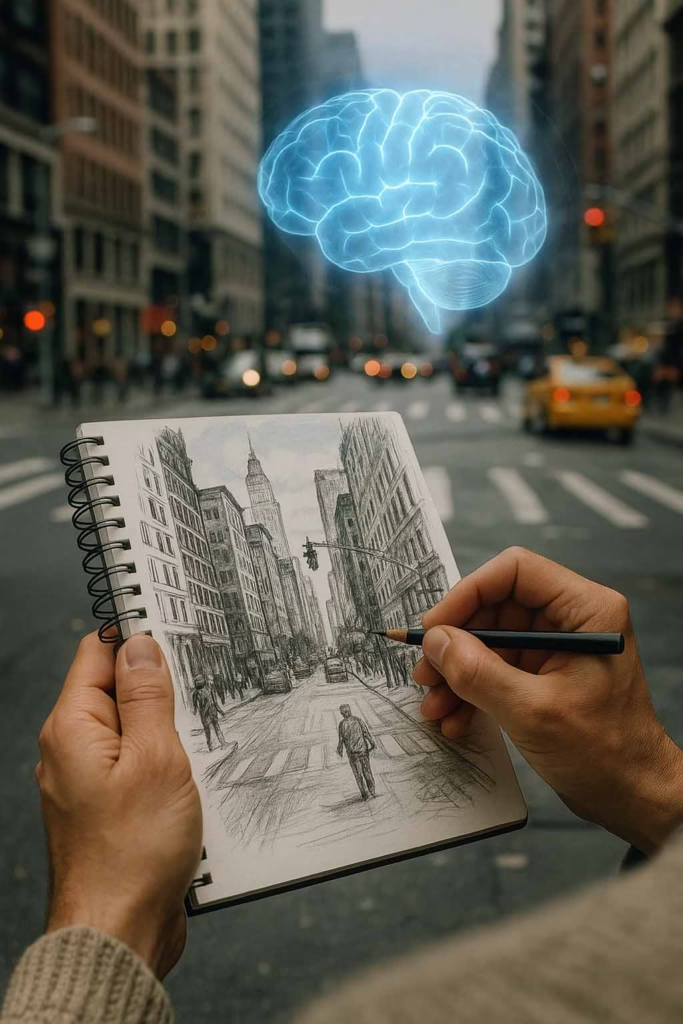
Mindfulness Meets Creativity
Dr. Sarah Chen’s 2024 Stanford study on urban sketching revealed fascinating neurological benefits that explain the movement’s magnetic appeal. When people sketch outdoors in groups, their brains show increased activity in regions associated with mindfulness, social bonding, and creative problem-solving simultaneously.
“Urban sketching creates a unique cognitive state,” Dr. Chen explains. “Participants enter a flow state similar to meditation, but with the added benefits of social connection and creative expression. It’s like triple-therapy for the modern mind.”
The research showed that regular urban sketchers reported:
- 68% reduction in anxiety levels
- 45% improvement in attention span
- 73% increase in feelings of community belonging
- 52% better sleep quality
Community Connection in the Digital Age
In an era where “social media” often feels anything but social, urban sketching offers authentic, face-to-face community building. The shared vulnerability of creating art in public creates bonds that transcend typical social barriers.
“There’s something magical about struggling with the same drawing problem together,” says Maria Rodriguez, who leads the Madrid Urban Sketchers chapter. “Age, profession, skill level—none of that matters when you’re all trying to capture the way light hits a building. You become equals in the pursuit of seeing.”
Cultural Documentation and Preservation
Urban sketchers serve as unofficial cultural historians, documenting cityscapes, street life, and cultural moments that might otherwise be forgotten. Their collective work creates a visual diary of urban evolution that’s more personal and diverse than traditional photography or journalism.
Cities like Barcelona and Portland have begun incorporating urban sketchers’ work into official cultural archives, recognizing the unique perspective these artists provide on urban development and community life.
Inside the Community: What Makes Urban Sketchers Different
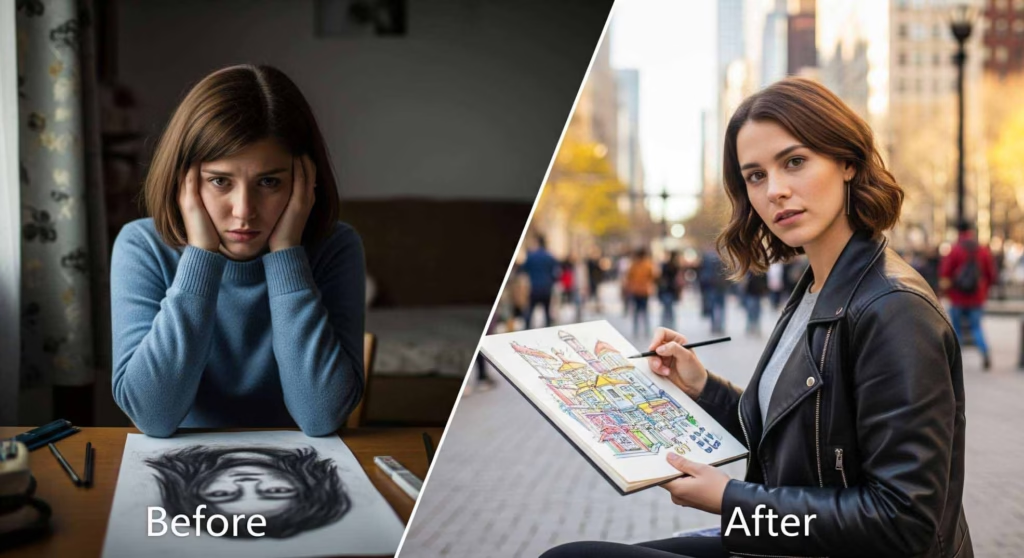
The “No Sketching Alone” Philosophy
While many art forms celebrate the solitary genius, urban sketching embraces collective creativity. The unofficial motto “Show the world, one drawing at a time” emphasizes community sharing over individual achievement.
This philosophy manifests in practical ways:
- Sketch crawls: Group walks through neighborhoods, stopping at interesting locations
- Drink and draws: Casual evening sessions at cafes or bars
- Skill sharing: Experienced artists naturally mentor newcomers
- Digital galleries: Online spaces where global communities share and celebrate each other’s work
Diversity and Inclusion Initiatives
Urban sketching communities have become models for inclusive art spaces. The movement’s emphasis on personal interpretation over technical perfection naturally welcomes artists of all skill levels and backgrounds.
Recent initiatives include:
- Adaptive sketching programs for artists with disabilities
- Language-free workshops that rely on visual demonstration
- Youth outreach programs in underserved communities
- Senior center partnerships combating isolation in elderly populations
Intergenerational Bonding
Perhaps most remarkably, urban sketching bridges generational gaps in ways few other activities achieve. Eight-year-old Emma sketching alongside 78-year-old Harold isn’t unusual—it’s the norm.
“My granddaughter and I started going to sketch meetups together,” says Harold Peterson from the Chicago chapter. “She teaches me about digital art techniques, and I show her architectural details she’s never noticed. We’ve both grown as artists and as friends.”
How to Join Your Local Urban Sketching Community (Complete Guide)
Finding Groups in Your City
Step 1: Check the Official Directory Visit urbansketchers.org and use their global directory. Most major cities have at least one active chapter, and many have multiple groups focused on different neighborhoods or skill levels.
Step 2: Social Media Search Search Facebook for “[Your City] Urban Sketchers” or check Instagram hashtags like #urbansketchers[yourcity]. Many groups coordinate exclusively through social media.
Step 3: Local Art Centers and Libraries Community art centers, libraries, and art supply stores often host or promote urban sketching groups. Call ahead or check their event calendars.
Step 4: Start Your Own If no group exists in your area, consider starting one. The Urban Sketchers organization provides starter kits and guidance for new chapter leaders.
What to Expect at Your First Meetup
Urban sketching meetups typically follow a relaxed format:
Arrival (15 minutes): Informal gathering, introductions, location scouting Sketching Time (60-90 minutes): Individual drawing with casual conversation Sharing Circle (15 minutes): Optional opportunity to show and discuss work Social Time (30+ minutes): Many groups adjourn to nearby cafes for continued conversation
First-Timer Tips:
- Arrive early to introduce yourself to organizers
- Bring whatever supplies you have—perfectionism not required
- Don’t worry about skill level—everyone started somewhere
- Take photos of your work to track progress
- Exchange contact information with people you connect with
Essential Supplies for Beginners
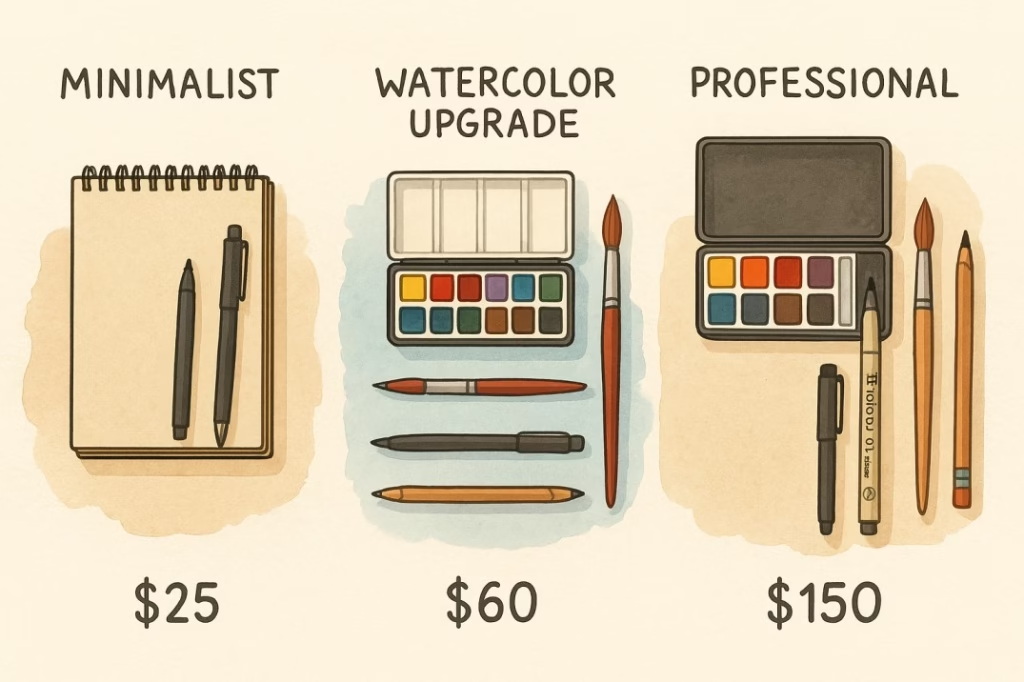
The Minimalist Kit ($25-40):
- Small sketchbook (5″x8″ or smaller for portability)
- 2-3 pencils (2H, HB, 2B)
- Basic eraser
- Black fine-tip pen
- Folding stool (optional but recommended)
The Watercolor Upgrade ($60-100):
- Watercolor sketchbook with heavier paper
- Compact watercolor set (12-24 colors)
- Water brush pens (eliminate need for water containers)
- Paper towels or small sponge
- Masking tape for clean edges
The Professional Setup ($150-300):
- High-quality watercolor paper blocks
- Professional watercolor tubes or pans
- Multiple brush sizes
- Portable easel
- Weather protection gear
Pro Tip: Start minimal and upgrade based on what you actually use. Many experienced urban sketchers work with surprisingly simple setups.
Online Communities for Remote Participants
Not everyone can attend in-person meetups, but the urban sketching community has embraced digital participation:
Virtual Sketch Sessions: Weekly Zoom meetups where participants sketch from their own locations while staying connected Monthly Challenges: Themed drawing prompts shared across social media platforms Tutorial Exchanges: Experienced artists share technique videos and tips Global Galleries: Digital spaces where remote sketchers share and receive feedback on their work
The Ripple Effect: How Urban Sketching Is Changing Cities
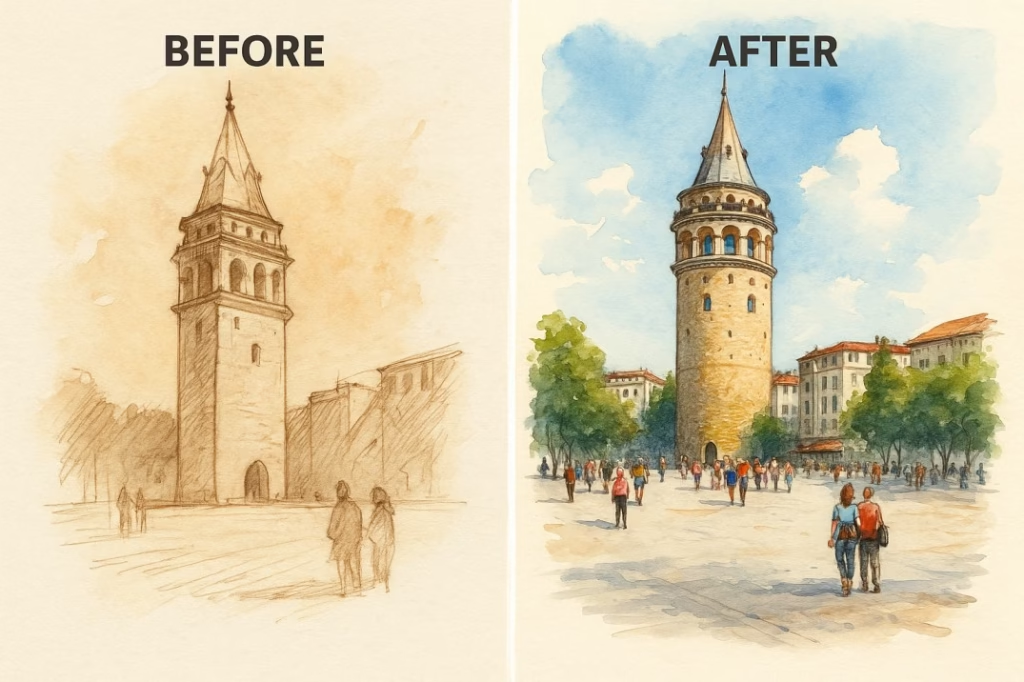
Tourism Boards Embracing Sketch Walks
Forward-thinking tourism boards have recognized urban sketching as a unique way to showcase their cities. Rather than promoting the same Instagram-famous spots, sketch walks highlight hidden gems and local perspectives.
Barcelona now offers official “Sketch the City” tours led by local artists, attracting culturally-minded tourists seeking authentic experiences.
Portland has integrated urban sketching into their “Creative City” branding, with sketch maps highlighting artist-friendly locations throughout the city.
Singapore launched a “Sketch Your Heritage” program, pairing urban sketchers with cultural historians to document changing neighborhoods.
Urban Planning Applications
City planners have begun recognizing urban sketchers as valuable community voices. The artists’ regular presence in public spaces and detailed observations of how spaces are actually used provide insights that traditional surveys often miss.
Case Study: Seattle’s Pike Place Market Renovation When Pike Place Market underwent major renovations in 2017-2019, planners consulted with the local Urban Sketchers chapter. The artists’ documentation of foot traffic patterns, lighting conditions, and community gathering spots influenced design decisions that preserved the market’s authentic character while improving functionality.
Mental Health Initiatives
Healthcare organizations have begun incorporating urban sketching into therapeutic programs, recognizing its unique combination of mindfulness, creativity, and social connection.

Veterans Administration Programs: Several VA hospitals now offer urban sketching as part of PTSD treatment, with remarkable success rates in reducing isolation and anxiety.
Senior Living Communities: Assisted living facilities partner with urban sketching groups to combat depression and cognitive decline in elderly residents.
Corporate Wellness: Companies like Google and Microsoft have integrated urban sketching into employee wellness programs, recognizing its stress-reduction benefits.
Success Stories: Lives Changed Through Street Journaling
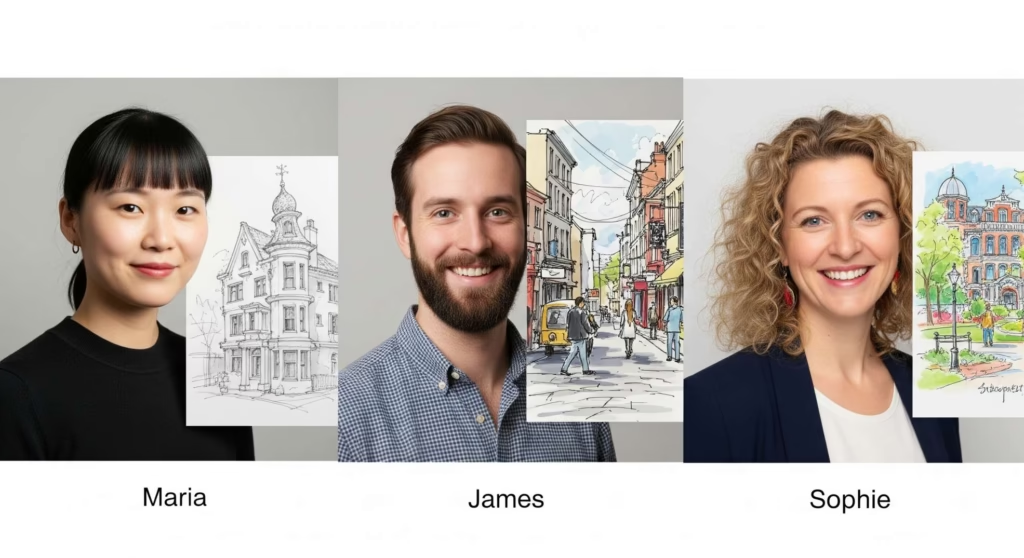
Maria’s Story: From Anxiety to Advocacy
Maria Santos, 34, joined the Los Angeles Urban Sketchers in 2019 while struggling with severe social anxiety. A graphic designer who worked primarily from home, she rarely left her apartment except for necessities.
“My first sketch walk was terrifying,” Maria recalls. “But something about having a pencil in my hand gave me permission to be there, to belong in that space.”
Within six months, Maria was leading weekend sketch walks. Within a year, she had launched “Sketchers Sin Fronteras,” a bilingual urban sketching program for immigrant communities in LA. Today, her program serves over 200 participants and has been replicated in five other cities.
“Urban sketching didn’t just help me overcome anxiety,” Maria reflects. “It gave me a purpose I never knew I was looking for.”
James’s Story: Retirement Renaissance
James Wilson, 67, retired from a 40-year engineering career feeling purposeless and disconnected. His wife suggested he try the local urban sketching group in Austin, Texas.
“I hadn’t drawn anything since high school,” James admits. “But I was desperate for something to do with my hands and my mind.”
Three years later, James has sketched in 15 countries, teaches monthly workshops for senior beginners, and has sold over 200 pieces of his urban sketching work. More importantly, he’s found a community of friends who share his curiosity about the world.
“Retirement could have been about decline,” James says. “Instead, it became about discovery.”
Sophie’s Story: Bridging Cultures
Sophie Chen, 19, moved from Beijing to study at the University of Toronto. Homesick and struggling with cultural adjustment, she discovered the Toronto Urban Sketchers through a campus bulletin board.
“Drawing the city helped me understand it,” Sophie explains. “Instead of feeling like an outsider looking at foreign buildings, I became someone interpreting and documenting my new home.”
Sophie’s sketches of Toronto’s multicultural neighborhoods, shared on Instagram, gained attention from the city’s tourism board. She now works part-time creating illustrated maps and cultural guides while completing her degree.
“Urban sketching taught me that every city has stories,” Sophie reflects. “And everyone who draws it becomes part of telling those stories.”
The Future of Urban Sketching: What’s Next
As urban sketching communities continue to evolve, several trends are shaping the movement’s future:
Technology Integration: While maintaining its analog roots, the community is embracing digital tools for sharing, organizing, and teaching. Apps like Procreate and digital sketch pads are becoming common alongside traditional materials.
Environmental Focus: Many chapters are incorporating environmental awareness into their mission, documenting climate change effects and promoting sustainable urban development through their art.
Professional Recognition: Art schools are beginning to offer urban sketching courses, and the practice is gaining recognition as a legitimate form of contemporary art and cultural documentation.
Global Exchange Programs: International sketch exchanges are becoming more common, with artists traveling to document other cities while hosting visitors in their own communities.
Join the Movement: Your City is Waiting
The beauty of urban sketching lies in its radical accessibility. You don’t need formal training, expensive equipment, or artistic credentials. You just need curiosity about the world around you and the courage to sit down and start drawing.
Every city has stories waiting to be told through your unique perspective. Every corner, every building, every moment of urban life offers an opportunity to slow down, observe, and connect—with your surroundings, with fellow artists, and with yourself.
The urban sketching community isn’t just about making art; it’s about making connections. It’s about transforming anonymous city spaces into familiar neighborhoods, turning strangers into friends, and discovering that the act of creation is always more meaningful when shared.
Ready to start your urban sketching journey?
- Find your local group at urbansketchers.org
- Grab a sketchbook and pencil—any will do
- Show up with curiosity—skills will follow
- Share your work—the community celebrates every attempt
- Keep showing up—consistency builds both skill and community
Your city is waiting to be seen through your eyes. The global community of urban sketchers is waiting to welcome you. And somewhere in the world, at this very moment, someone is sitting on a park bench with a sketchbook, documenting their corner of the urban world and inviting you to do the same.
The movement that started with eight people in a Seattle coffee shop is now 2.3 million strong. But it’s still growing, one sketch at a time, one artist at a time, one community at a time.
Welcome to urban sketching. Your adventure starts now.
Want to dive deeper into the urban sketching world? Download our free “Urban Sketching Community Starter Kit” with local group finder tools, essential supply lists, and your first 30-day sketching challenge. Join thousands of artists who’ve discovered the joy of documenting their cities one drawing at a time.

